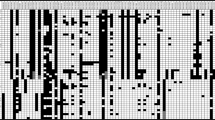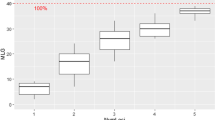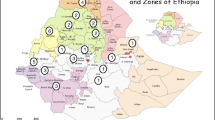Abstract
The selection of parents is the most crucial step in any breeding programme. A better understanding of genetic diversity among the available genotypes would help the breeder to make better crosses. Advancements of DNA marker techniques in many crops have supplemented the morphological traits with molecular markers to identify the diverse genotypes. The genetic diversity of 30 sugarcane genotypes differing in response to red rot resistance was carried out using simple sequence repeat (SSR) markers. The polymorphism information content (PIC) ranged from 0.216 to 0.813 with an average of 0.525. The highest values (0.86) of proportion of polymorphic loci (P) and expected heterozygosity (He) were obtained in the susceptible population (S) and moderately resistant population (MR), respectively. FST values between populations ranged from −0.043 to 0.041. However, AMOVA did not show much variation among the groups. Cluster analysis clearly distinguished all the genotypes from each other. The resistant genotypes namely ISH150 and SES594 emerged out to be most distinct genotypes, whereas the rest of the genotypes could be grouped in two broad clusters separating the moderately resistant and susceptible sugarcane genotypes. The clustering pattern was fairly supported by Mantel’s test (r = 0.894) and high bootstrap value (75.0%). Thus, information given in the present study can be used in genetic resource management as well as in broadening the genetic base of cultivated sugarcane for red rot and selection of suitable parent for generating the mapping population for tagging the red rot resistance gene(s) in sugarcane.


Similar content being viewed by others
References
Aitken, K.S., P.A. Jackson, and C.L. McIntyre. 2005. A combination of AFLP and SSR markers provides extensive map coverage and identification of homo(eo)logous linkage groups in a sugarcane cultivar. Theoretical and Applied Genetics 110: 789–801.
Ali, M.A., M.T. Seyal, S.I. Awan, S. Niaz, S. Ali, and A. Abbas. 2008. Hybrid authentication in upland cotton through RAPD analysis. Australian Journal of Crop Science 2(3): 141–149.
Alwa, S., C.A. Kimbeng, K.A. Gravois, and K.P. Bischoff. 2006. TRAP, a new tool for sugarcane breeding: comparison with AFLP and coefficient of parentage. Journal American Society Sugar Cane Technologists 26: 62–85.
Chen, F., D. Chen, Z. Gao, and X. Chen. 2010. Analysis of diversity in Chinese cultivated barley with simple sequence repeats: differences between eco-geographic populations. Biochemical Genetics 48: 44–56.
Chona, B.L. 1954. Studies on the diseases of sugarcane in India. IV Relative resistance of sugarcane varieties to red rot. Indian Journal of Agricultural Sciences 24: 301–315.
Cordeiro, G.M., R. Casu, C.L. McIntyre, J.M. Manners, and R.J. Henry. 2001. Microsatellite markers from sugarcane (Saccharum spp.) ESTs cross transferable to Erianthus and sorghum. Plant Science 160: 1115–1123.
Cordeiro, G.M., Y.B. Pan, and R.J. Henry. 2003. Sugarcane microsatellites for the assessment of genetic diversity in sugarcane germplasm. Plant Science 165: 181–189.
Daniels, J., and C.A. Daniels. 1976. A note on red rot disease. Physalospora tucumanensis Speg., and origin of sugarcane. Sugarcane Breeding News Letter 37: 17–19.
Daniels, J., and B.T. Roach. 1987. Taxonomy and evolution. In Sugarcane Improvement through breeding, ed. D.J. Heinz, 7–84. Amsterdam: Elsevier Press.
D’Hont, A., D. Ison, K. Alix, C. Roux, and J.C. Glaszmann. 1998. Determination of basic chromosome numbers in the genus Saccharum by physical mapping of ribosomal RNA genes. Genome 41: 221–225.
Doyle, J.J., and J.L. Doyle. 1990. Isolation of plant DNA from fresh tissue. Focus 12: 13–14.
Excoffier, L., P.E. Smouse, and J.M. Quattro. 1992. Analysis of molecular variance inferred from metric distances among DNA haplotypes: applications to human mitochondrial DNA restriction sites. Genetics 131: 479–491.
Fregene, M., A. Bernal, M. Duque, A. Dixon, and J. Tohme. 2000. AFLP analysis of African cassava (Monihot esculenta Crantz). Theoretical and Applied Genetics 100: 673–685.
Govindaraj, P., U.S. Natarajan, N. Balasundaram, Premachandran, T.R. Sharma, K.R. Kaundal, K.C. Bansal, and N.K. Singh. 2005. Development of new microsatellite markers for identification of interspecific hybrids in sugarcane. Sugar Cane International 23: 30–34.
Gupta, A.K., and V. Yadav. 2009. Evaluation of different sugarcane varieties for resistance against red rot disease. Environment and Ecology 27(3): 1006–1008.
Hartl, D.L. 1987. A primer of population genetics, 2nd ed. Sunderland: Sinauer Associates Inc.
Kirtkar, and H.S. Verma. 1963. Role of chemical in sugarcane disease control. Indian Sugar 13: 139–141.
Lynch, M., and B.G. Milligan. 1994. Analysis of population genetic structure with RAPD markers. Molecular Ecology 3: 91–99.
Mateescu, R.G., Z. Zhang, K. Tsai, J. Phavaphutanon, N.I. Burton-Wurster, G. Lust, R. Quaas, K. Murrphy, G.M. Acland, and R.J. Todhunter. 2005. Analysis of allele fidelity, polymorhic information content, and density of microsatellites in a genome-wide screening for hip dysplasia in a crossbreed pedigree. Journal of Heredity 96: 847–853.
Panje, R.R., and C.N. Babu. 1960. Studies in Saccharum spontaneum. Distribution and geographical associations of chromosome number. Cytologia 25: 152–172.
Pan, Y.B. 2006. Highly polymorphic microsatellite DNA markers for sugarcane germplasm evaluation and variety identity testing. Sugar Tech 8: 246–256.
Pan, Y.B., J.D. Miller, R.J. Schnell Jr, E.P. Richard, and Q. Wei. 2003. Application of microsatellite and RAPD fingerprints in Florida sugarcane variety program. Sugarcane International 20: 19–24.
Rohlf, F.J. 1998. NTSYS-PC numerical taxonomy and multivariate analysis system, version. Setauket, New York: Exeter Software.
Schlotterer, C. 2004. The evolution of molecular markers-just matter of fashion? Nature Rev Genet 5: 63–69.
Selvi, A., N. Mukunthan, R.M. Shanthi, P. Govindaraj, B. Singaravelu, and T.K. Prabu. 2008. Assessment of genetic relationships and marker identification in sugarcane cultivars with different levels of top borer resistance. Sugar Tech 10: 53–59.
Selvi, A., N.V. Nair, N. Balasundaram, and T. Mohapatra. 2003. Evaluation of maize microsatellite markers for genetic diversity analysis and fingerprinting in sugarcane. Genome 46: 394–403.
Singh, K. 1973. Hot air therapy against red rot of sugarcane. Plant Disease Report 57: 220–222.
Singh, R.K., J. Singh, M.S. Khan, and H.L. Madhok. 2007. Genetic purity of micropropagated plantlets in Sugarcane using SSR markers National Symposium on Seed Cane, IISR, Lucknow.
Singh, R.P., and V.P. Agnihotri. 1987. Thermo-therapy of sugarcane for disease control. In Review of tropical plant pathology, vol. IV, ed. S.P. Raychaudhary, and J.P. Verma, 305–329. New Delhi: Today and Tommarow’s Printers and Publication.
Sun, G., M. Bond, H. Nass, R. Martin, and Z. Doung. 2003. RAPD polymorphism in spring wheat cultivars and lines with different level of Fusarium resistance. Theoretical and Applied Genetics 106: 1059–1067.
Virupakshi, S., and G.R. Naik. 2008. ISSR analysis of chloroplast and mitochondrial genome can indicate the diversity in sugarcane genotypes for red rot resistance. Sugar Tech 10: 65–70.
Venkatraman, S.T. 1925. Sugarcane breeding in India: hybridization to testing. Agricultural Journal of India 29(3): 173–176.
Wei, X., P.A. Jackson, C.L. McIntyre, K.S. Aitken, and B. Croft. 2006. Association between DNA markers and resistance to diseases in sugarcane and effects of population structure. Theoretical and Applied Genetics 114: 155–164.
Went, F.A.F.C. 1893. Het Rood Snot. ArchJava Suikerind 1: 243–265.
Wright, S. 1965. The interpretation of population structure by F-statistics with special regard to systems of mating. Evolution 19: 395–420.
Yadav, R.L. 2006. Research vision to manage red rot disease of sugarcane in India. Sugar Tech 8: 99–100.
Yap, I., and R.J. Nelson. 1996. Winboot. A program for performing bootstrap analysis of binary data to determine the confidence limits of UPGMAbased dendrograms. IRRI Discussion paper series no. 14. International Rice Research Institute, Manila, Philippines.
Acknowledgments
The authors gratefully acknowledge the support and encouragement provided by Dr. R. L. Yadav, Director, IISR, Lucknow.
Author information
Authors and Affiliations
Corresponding author
Rights and permissions
About this article
Cite this article
Singh, R.K., Khan, M.S., Singh, R. et al. Analysis of Genetic Differentiation and Phylogenetic Relationships among Sugarcane Genotypes Differing in Response to Red Rot. Sugar Tech 13, 137–144 (2011). https://doi.org/10.1007/s12355-011-0076-2
Received:
Accepted:
Published:
Issue Date:
DOI: https://doi.org/10.1007/s12355-011-0076-2




